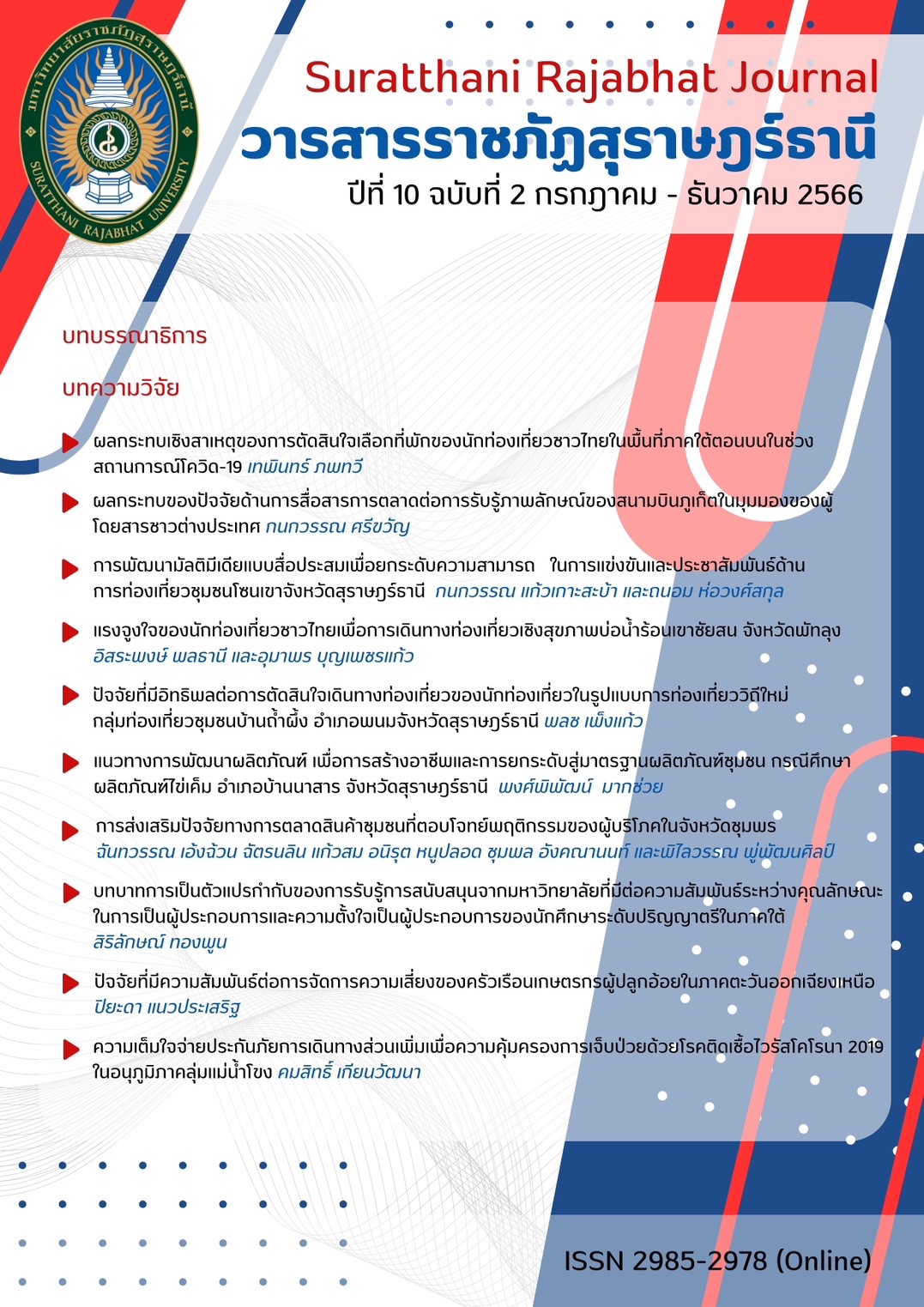The Motivation of Thai Tourists for Health Tourism in Khao Chai Son Hot Spring, Phatthalung Province
Main Article Content
Abstract
The objectives of this research were to study the motivation of Thai tourists for health tourism at Khao Chaison Hot Spring in Phatthalung Province and compare the demographic characteristics on the pushing and pulling motivations of health tourism at Khao Chaison Hot Spring. The sample group used in this research consisted of 381 Thai tourists visiting Khao Chaison Hot Spring. Questionnaires were used to collect data using an accidental sampling method. The questionnaire has a reliability value of between 0.807 and 0.854. The data was analyzeds by descriptive and inferential statistics.
The results showed that most of the respondents were female, aged 31–40 years, single status, with a bachelor's degree, working as civil officers and state enterprise employees, earning between 20,001 and 30,000 baht. Most of them used to visit the hot spring. They used a private car, travelling with their families, spending less than 500 baht, and considering to come back again. The results of the comparison of the level of motivation to travel to Khao Chaison Hot Spring according to personal factors with more than two population groups found that different gender, age, status, and income factors had different levels of motivation for visiting Khao Chaison Hot Spring at a statistically significant level of .05.
Article Details

This work is licensed under a Creative Commons Attribution-NonCommercial-NoDerivatives 4.0 International License.
References
Buaphueak, S. (2007). Thai Tourists' Behavior and Satisfaction Towards Tourist Attractions in Koh Kred Nonthaburi Province [Unpublished master’s thesis]. Srinakharinwirot University.
Chatkul, N. (2012). Tourism Industry. Chulalongkorn University.
Cohen, J. (1977). Statistical Power Analysis for the Behavioral Sciences (Rev. ed.). Lawrence Erlbaum Associates, Inc.
Dalen, J. E., & Alpert, J. S. (2019). Medical tourists: Incoming and outgoing. The American Journal of Medicine, 132(1), 9–10. https://doi.org/10.1016/j.amjmed.2018.06.022
Dann, G. M. (1981). Tourist Motivation an Appraisal. Annals of Tourism Research, 8, 187-219. https://doi.org/10.1016/0160-7383(81)90082-7
Department Of Mineral Resources. (2016). Types and benefits of soaking in hot springs.http://www.dmr.go.th/ewtadmin/ewt/dmr_web/main.php?filename=type.
Faul, F., Erdfelder, E., Lang, A. G. & Buchner, A., (2007). G*Power 3: A flexible statistical power analysis program for the social, behavioral, and biomedical sciences. Behavior Research Methods, 39(2), 175-191. https://doi.org/10.3758/bf03193146.
Faul, F., Erdfelder, E., Buchner, A. & Lang, A. G., (2009). G*Power 3.1: Tests for correlation and regression analysis. Behavior Research Methods, 41(4), 1149-1160. https://doi.org/10.3758/BRM.41.4.1149
Han, H., Lee, M. J., Chua, B. L., & Kim, W. (2019). Triggers of traveler willingness to use and recommend eco-friendly airplanes. Journal of Hospitality and Tourism Management, 38, 91–101. https://doi.org/10.1016/j.jhtm.2019.01.001
Hoz-correa, A. D. L. & Munoz-Leiva, F. (2019). The role of information sources and image on the intention to visit a medical tourism destination: a cross-cultural analysis, 36(2), 204-219. Journal of Travel & Tourism Marketing. https://doi.org/10.1080/10548408.2018.1507865
Jermnasiri, N. (2012). Agricultural tourism development. Thailand Center of Excellence in Physics.
Khao Chaison Subdistrict Administrative Organization. (2016). Khao Chaison Hot Spring. http://khaochaison.go.th/?p=4202.
Kumar, A., Roach, C., Hirsh, I. S., Turley, S., Dewalque, S., Michels, P. A.M. & Hol, W. G.J. (2001). An unexpected extended conformation for the third TPR motif of the peroxin PEX5 from Trypanosoma brucei. J MolBiol, 307(1), 271-82. https://doi.org/10.1006/jmbi.2000.4465
Muskat, B., Hortnagl, T., Prayag, G., & Wagner, S. (2019). Perceived quality, authenticity, and price in tourists’ dining experiences: Testing competing models of satisfaction and behavioral intentions. Journal of Vacation Marketing, 25(4), 480–498. https://doi.org/10.1177/1356766718822675
Office of the National Economics and Social Development Council. (2017). Draft 20-year national strategy (2017-2036). www.nesdb.go.th/download/document/SAC/NS_Draftplan-Aug2017.pdf
Permanent Secretary of Ministry of Tourism and Sports. (2016). Tourism economic report. http://www.mots.go.th/ewt_dl_link.php?nid=7622.
Phisertsalasai, P. (2009). Behavior and motivation of Thai tourists towards Bang Noi Floating Market Samut Songkhram Province [Unpublished master’s thesis]. Nakhon Pathom University.
Taheri, B., Chalmers, D., Wilson, J., & Arshed, N. (2020). Would you really recommend it? Antecedents of word-of-mouth in medical tourism. Tourism Management, 83, 104-209. https://doi.org/10.1016/j.tourman.2020.104209
Theeranon, S. & Sopolcharasakul, P. (2016). creative tourism Choices - Survival of Thai tourism. Pathumthani University Academic Journal, 8(2), 206 - 215.
Worakulwit, S. (2015). Tourism Industry. Pimwaw.
Wongthaweesub, C. (2007). Tourist satisfaction with tourist attractions Nakhon Pathom [Unpublished master’s thesis]. Nakhon Pathom Rajabhat University.
Zhi, G. Y. J., Flaherty, G. T., & Hallahan, B. (2019). Final journeys: Exploring the realities of suicide tourism. Journal of Travel Medicine, 26(3), https://doi.org/10.1093/jtm/taz016


